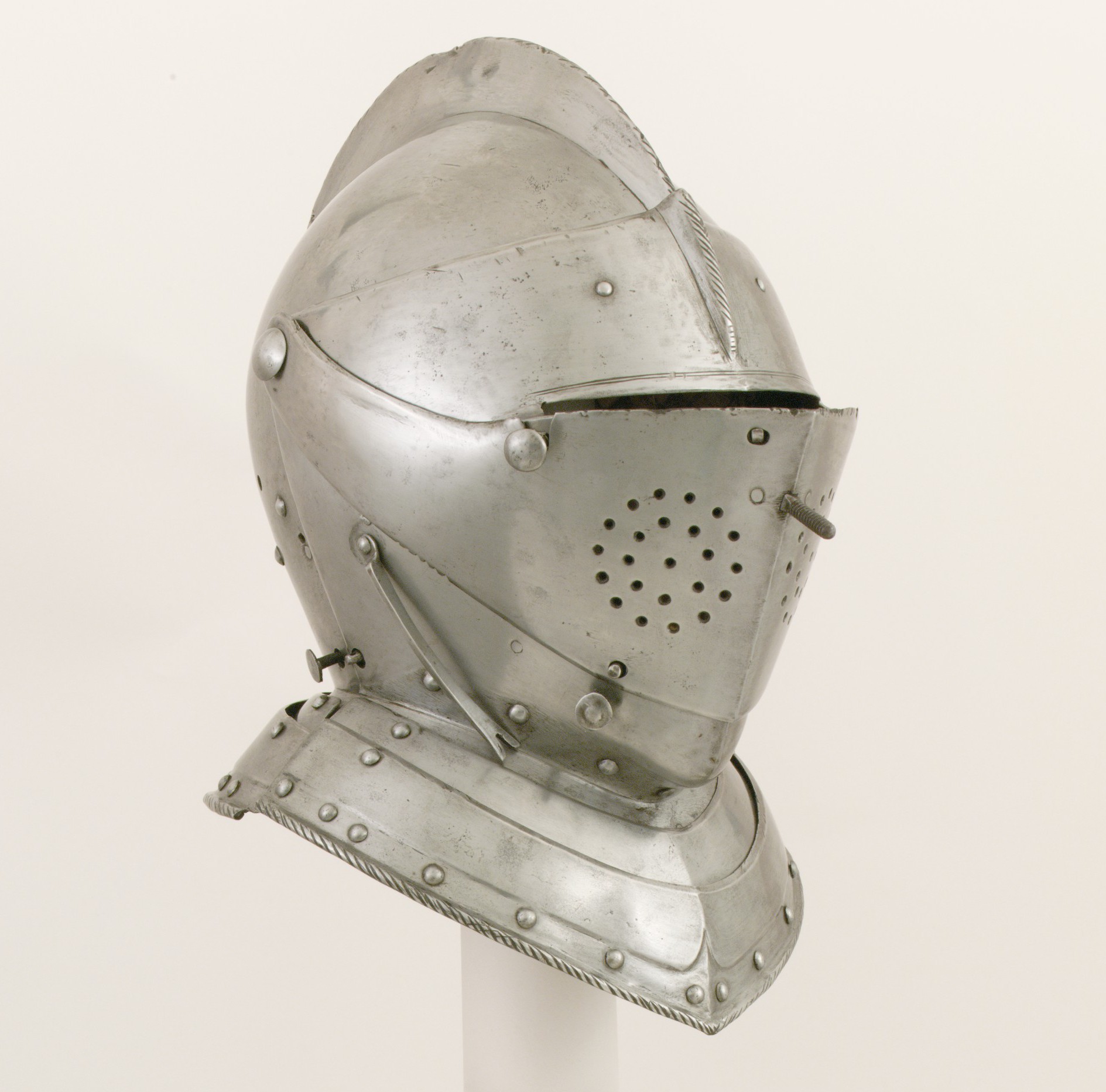
In stock replica of an English closed helm The Closed Helmet, a
Meet this modest and laconic close-helmet incorporating a sallet skull and brow reinforcement with an armet visor. Dating back to 1480, it was found at St Peter's Church, Stourton, Wiltshire and now is exposed at the Royal Armories, Leeds. It is a typical helmet for the late XVth century, widespread in Italy, France, the Low Countries, Spain.
Close Helmet Italian The Metropolitan Museum of Art
The close helmet, also called the close helm was a military helmet worn by knights and other men-at-arms in the Late Medieval and Renaissance eras. It was also used by some heavily armoured, pistol-armed, cuirassiers into the mid 17th century. It was a fully enclosing helmet with a pivoting visor and integral bevor. Contents Characteristics

CloseHelmet for the Tournament German, probably Augsburg The
Close Helmet (1 - 60 of 248 results) Price ($) Shipping All Sellers Medieval Knight Burgonet Helmet Wearable Plate Armor Costume Silver | Medieval Combat Close Helmet | Steel Spartan Funta Armor Helmet $194.35 $299.00 (35% off) FREE shipping Somewhat Authentic Close Helmet (48) $85.01

Close Helmet Historic Jamestowne
Close-Helmet Italian, Milan or Brescia ca. 1515, and later Not on view The bowl of this helmet is the sole surviving fragment of a rare etched and gilt Italian close-helmet "in the German style" ( alla tedesca ).
Close Helmet of Claude Gouffier (15011570) French The Met
Close-Helmet British or Flemish ca. 1560 Not on view The prow-like lower visor of this helmet is the most recognizable characteristic of a distinctive style that was made about the middle of the sixteenth century in either England or Flanders.

» Close Helmet
Conquer the city in style, safety and convenience with award-winning collapsible bicycle helmet Closca Helmet, a cool bike folding helmet for men and women.. Clear Close. Zoom. Zoom. Zoom. Zoom. Closca Helmet Abyss. Sale price €119.90 Regular price €149.90 (/) Sold out Save 20%. 4.9. Elegant, practical, and of course, safe. An Icon since.

Pin on armour
Close Helmet Close Helmet Iron Origin: Netherlands, Early 17th Century Context: James Fort Blacksmith Shop/Bakery The helmet would have been part of a full suit of personal armor that a gentleman himself would commission or purchase, as opposed to the type of protection supplied by the Virginia Company to lower status individuals.

Philadelphia Museum of Art Collections Object Close Helmet, for Use
Close Helmet Prev Next Close Helmet ID: 11119 The most popular helmet of the XVI century: close helmet with a visor "sparrow's beak". Helmet was developed on the base of Sallet with bevor. Close helmet looks like Armet but in fact it's different. First close helmets were similar to sallet with the short tail.

Pin on Armor inspiration.
The most popular helmet of the XVI century: close helmet with a visor "sparrow's beak". Close helmet can be made of mild steel, tempered steel, stainless st.
Close Helmet for a Cuirassier Italian The Metropolitan Museum of Art
The Close Helmet, a timeless and iconic piece of medieval armor, is reimagined with a fusion of historical accuracy and cutting-edge technology through Formlabs Form 3L and Applylabworks Black Pro Resin.

German Close Helmet Late 16th Century Helmet armor, Knights helmet
Interior of an infantry officer's tent, with close-up on a desk featuring writing equipment and drinking vessels, from Whitby Abbey, 2021. More info Close. Officer's tent interior.. The Intercisa is the most enduring helmet seen in the late Roman sphere, this reconstruction by the Pustelak Brothers Art Workshop and photograph with kind.
CloseHelmet for the Field Italian The Metropolitan Museum of Art
A close helmet encloses the head (as opposed to a sallet). This type combines the rounded Italian shape with the crisp, vertical fluting, crest, and corded borders that evolved from German late-medieval armor. The fluting deflected projectiles and made the plate stronger without adding weight.
.jpg)
A EUROPEAN CLOSE HELMET FROM A CUIRASSIER ARMOUR , EARLY 17TH CENTURY
The close helmet or close helm is a type of combat helmet that was worn by knights and other men-at-arms in the Late Medieval and Renaissance eras. It was also used by some heavily armoured, pistol-armed cuirassiers into the mid- 17th century. It is a fully enclosing helmet with a pivoting visor and integral bevor . Characteristics[edit]

German Close Helmet 1505 Medieval helmets, Ancient armor, Historical
The close helmet, also called the close helm was a military helmet worn by knights and other men-at-arms in the Late Medieval and Renaissance eras. It was also used by some heavily armoured, pistol-armed, cuirassiers into the mid 17th century. It was a fully enclosing helmet with a pivoting visor and integral bevor . Contents 1 Characteristics
.jpg?mode=max)
An English CloseHelmet
Close Burgonet Helmet. This is the only close burgonet helmet found by Jamestown Rediscovery archaeologists. Introduced in the early 16th century, the close burgonet helmet was designed to provide full head and face protection while evoking classical military authority. In Europe, this type of helmet was mostly worn by cavalry.
FileGerman Close Helmet of the "Maximilian" Style Walters 51465
The close helmet or close helm is a type of combat helmet that was worn by knights and other men-at-arms in the Late Medieval and Renaissance eras. It was also used by some heavily armoured, pistol-armed cuirassiers into the mid- 17th century. It is a fully enclosing helmet with a pivoting visor and integral bevor.